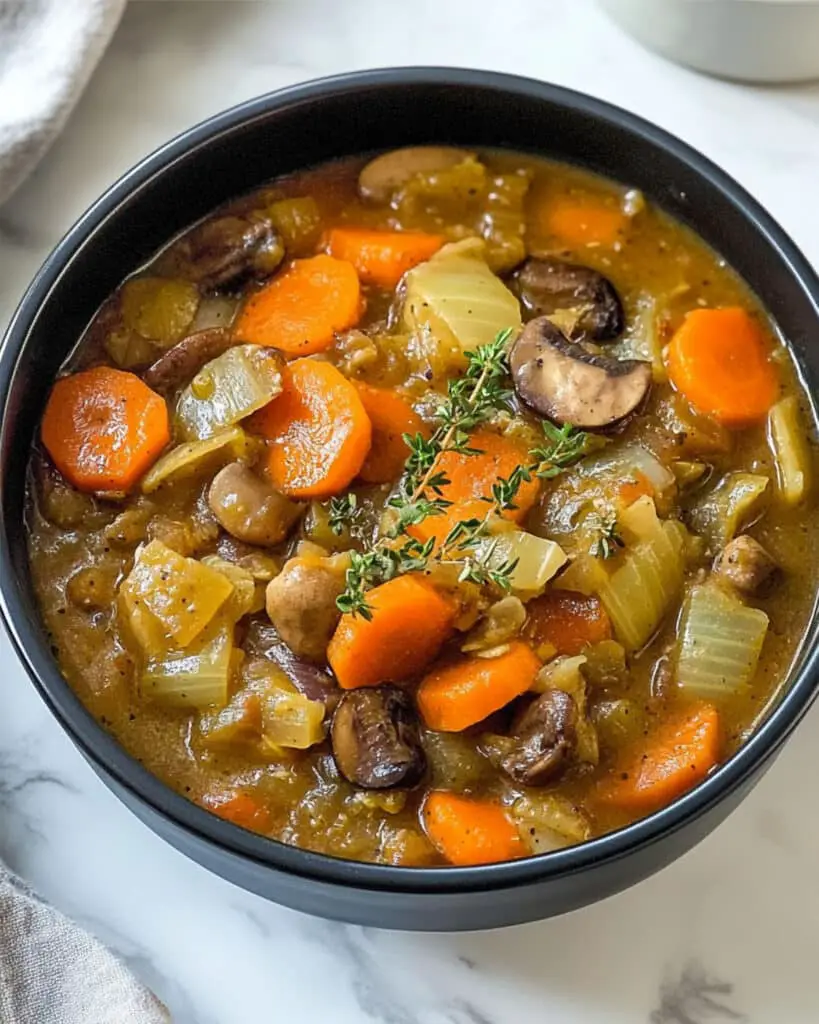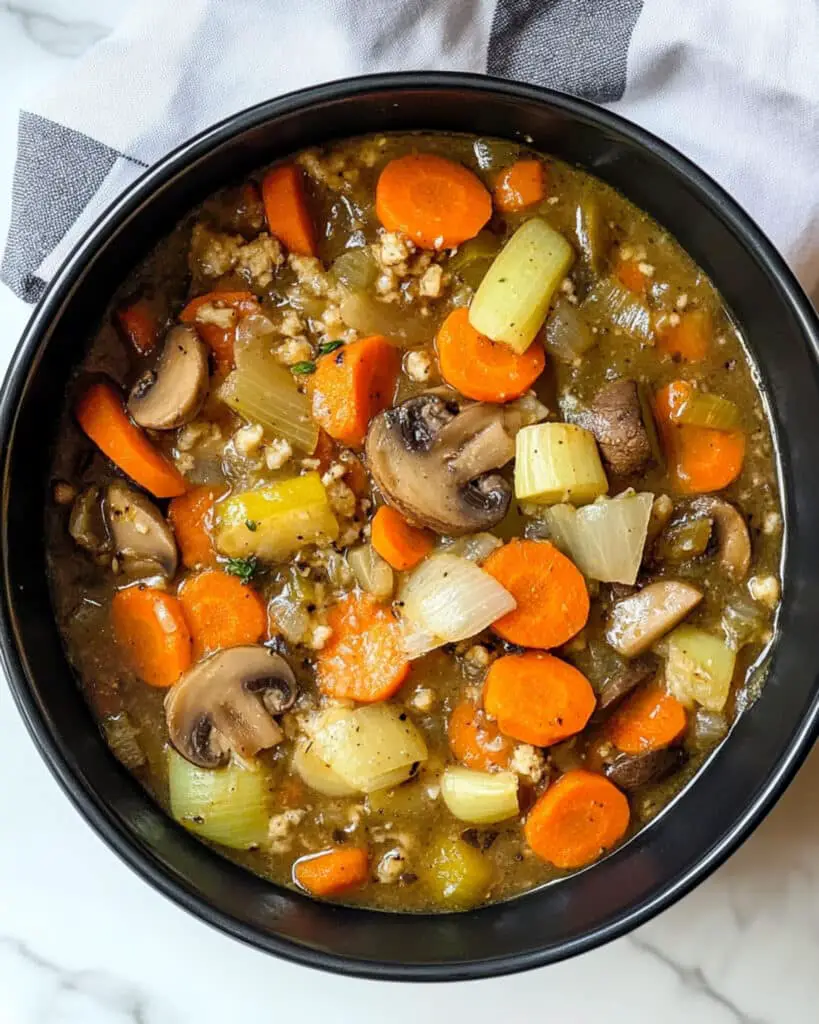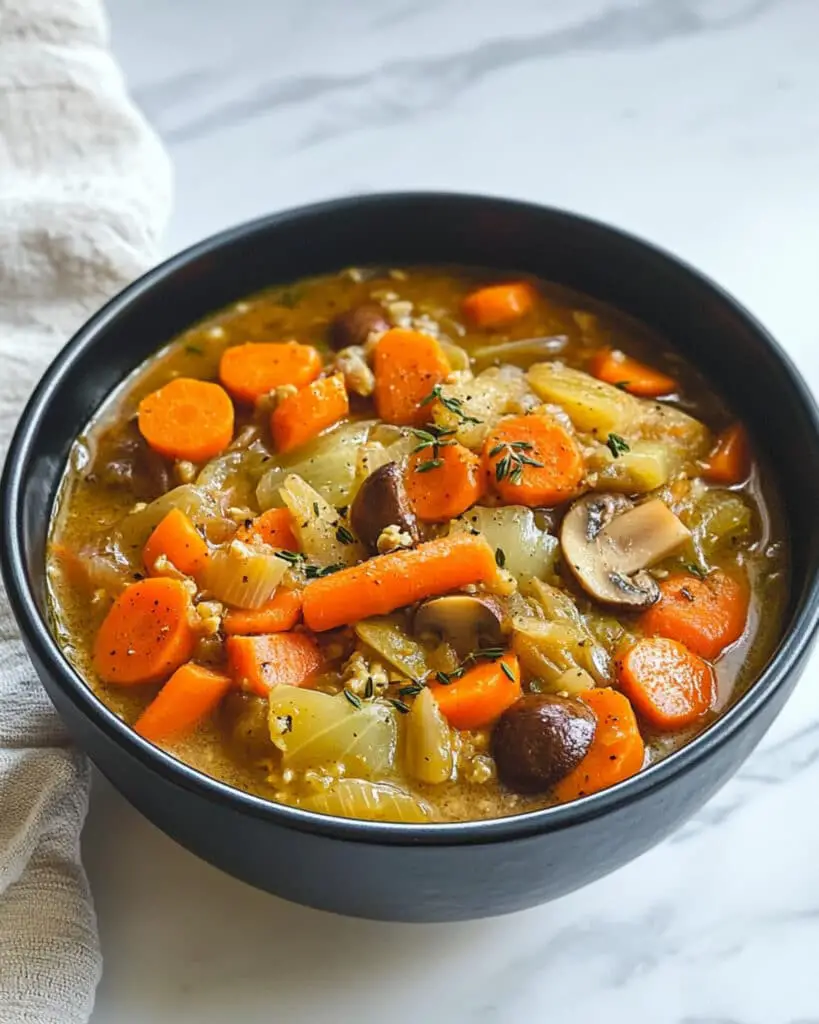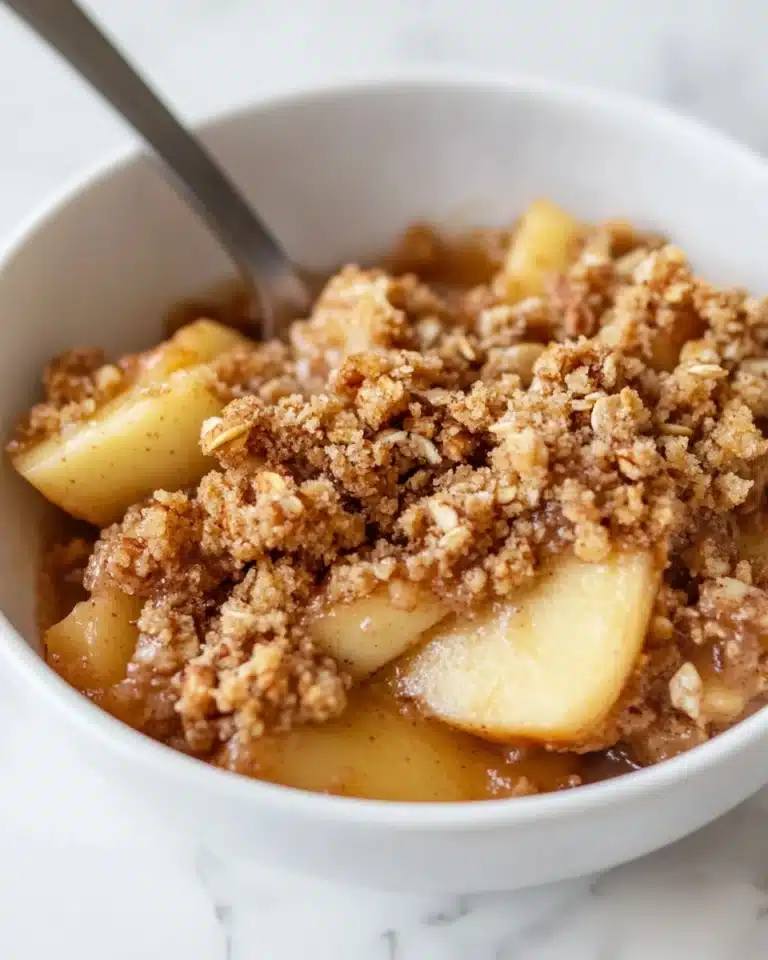This Colonial Vegetable Pottage is a hearty and nourishing dish inspired by early American cuisine. A medley of root vegetables, cabbage, and mushrooms simmered in a rich broth with herbs and oats, it’s a simple yet satisfying meal that’s perfect for a cozy evening or a historical reenactment feast.
Why You’ll Love This Recipe
- Flavorful and Hearty: This pottage is packed with the earthy flavors of root vegetables, cabbage, and mushrooms, creating a comforting and satisfying dish.
- Easy to Make: With simple ingredients and straightforward instructions, this recipe is a breeze to prepare, even for beginner cooks.
- Historically Inspired: This dish offers a glimpse into the culinary traditions of early American settlers, making it a fun and educational cooking experience.

Ingredients
Here’s what you’ll need to make this delicious Colonial Vegetable Pottage:
- Carrots: Peeled and diced, for sweetness and color.
- Onion: Diced, for flavor and texture.
- Root vegetable: Parsnip or turnip, peeled and diced, adds a unique flavor and texture.
- Leek: Cleaned and roughly chopped, for a mild onion flavor.
- Cabbage: Roughly chopped, adds texture and a slightly sweet flavor.
- Mushrooms: Any type will do, roughly chopped, for an earthy flavor and umami.
- Dried thyme, rosemary, and sage: Adds a blend of classic herbs for a warm and savory flavor.
- Stock: Use vegetable or chicken stock for a flavorful base.
- Bay leaf: Adds a subtle aromatic flavor.
- Rolled oats: Adds heartiness and thickness to the pottage.
- Vinegar: Adds a touch of acidity to balance the flavors.
- Kosher salt and freshly cracked black pepper: To taste.
Note: You’ll find the complete list of ingredients, along with their exact measurements, in the printable recipe card at the bottom of this post.
How to Make Colonial Vegetable Pottage
Step 1: Cook the Root Vegetables
In a large pot or Dutch oven, combine the diced carrots, onion, root vegetable (parsnip or turnip), and ¼ cup of the stock. Cook over medium heat for 10 minutes, or until the vegetables are slightly softened.
Step 2: Add Remaining Vegetables and Herbs
Add the chopped leek, cabbage, mushrooms, dried thyme, rosemary, and sage to the pot. Cook for another 5 minutes, stirring occasionally, until the vegetables are slightly wilted.
Step 3: Simmer with Stock
Pour in the remaining stock and add the bay leaf. Bring the mixture to a boil, then reduce the heat to low and simmer partially covered for 30 minutes, or until the vegetables are tender.
Step 4: Add Oats and Thicken
Stir in the rolled oats and continue to cook uncovered for another 20 minutes, or until the oats are cooked through and the pottage has thickened.
Step 5: Season and Serve
Remove the bay leaf. Stir in the vinegar and season with salt and pepper to taste. Serve hot and enjoy!
Pro Tips for Making the Recipe
- Cut vegetables evenly: Try to cut the vegetables into similar-sized pieces so they cook evenly.
- Adjust the consistency: If the pottage is too thick, add more stock or water. If it’s too thin, simmer it uncovered for a longer time to reduce the liquid.
- Customize the herbs: Feel free to adjust the amount of herbs or add other herbs, such as parsley or bay leaves, to your liking.
How to Serve Colonial Vegetable Pottage

- Hearty Meal: This Colonial Vegetable Pottage is a complete and satisfying meal on its own, especially when served with crusty bread.
- Side Dish: Serve it as a side dish with roasted meats or other hearty dishes.
- Historical Feast: This pottage is a perfect addition to a historical reenactment feast or a themed dinner party.
Make Ahead and Storage
Storing Leftovers
Leftovers can be stored in an airtight container in the refrigerator for up to 3 days.
Reheating
Reheat gently on the stovetop or in the microwave until warmed through.

FAQs
Can I use different vegetables in this pottage?
Absolutely! Feel free to add other vegetables, such as potatoes, turnips, or squash.
Can I make this pottage in a slow cooker?
Yes, you can! Add all the ingredients to a slow cooker and cook on low for 6-8 hours, or until the vegetables are tender.
Can I make this pottage vegan?
Yes, you can use vegetable broth and omit the butter or use a vegan butter substitute.
How can I make this pottage thicker?
You can add more rolled oats or mash some of the vegetables to thicken the pottage.
There you have it! A delicious and easy-to-follow recipe for Colonial Vegetable Pottage that’s perfect for a hearty and comforting meal. Enjoy!
Print
Colonial Vegetable Pottage Recipe
- Prep Time: 15 minutes
- Cook Time: 55 minutes
- Total Time: 1 hour 10 minutes
- Yield: 36 cookies 1x
- Category: Soup
- Method: Stovetop
- Cuisine: American
Description
This Colonial Vegetable Pottage is a hearty and comforting stew that’s perfect for a cozy fall or winter meal. A medley of root vegetables, cabbage, and mushrooms simmer in a flavorful broth with herbs and oats, making for a satisfying and nourishing dish.
Ingredients
- 1 cup carrots, peeled and diced
- 1 cup onion, diced
- 1 cup root vegetable (parsnip or turnip), peeled and diced
- 1 cup leek, cleaned and roughly chopped
- 1 cup cabbage, roughly chopped
- 1 cup mushrooms (any variety), roughly chopped
- 1/2 teaspoon dried thyme
- 1/2 teaspoon dried rosemary
- 1/2 teaspoon ground sage
- 8 cups vegetable or chicken stock
- 1 bay leaf
- 1 cup rolled oats
- 1 tablespoon vinegar (such as apple cider vinegar)
- Kosher salt and freshly cracked black pepper, to taste
Instructions
- Cook Root Vegetables: In a large pot or Dutch oven, combine carrots, onion, root vegetables (parsnip or turnip), and ¼ cup of the stock. Cook over medium heat for 10 minutes, or until vegetables begin to soften.
- Add Remaining Vegetables and Herbs: Add leeks, cabbage, mushrooms, thyme, rosemary, and sage to the pot. Cook for 5 minutes, stirring occasionally.
- Simmer with Stock: Pour in the remaining stock and add the bay leaf. Bring to a boil, then reduce heat and simmer partially covered for 30 minutes.
- Add Oats: Stir in rolled oats and continue to simmer uncovered for 20 minutes, or until the oats are tender and the soup has thickened.
- Season and Serve: Remove the bay leaf. Stir in vinegar and season with salt and pepper to taste. Serve hot.
Notes
- Vegetables: Feel free to substitute or add other vegetables, such as potatoes, celery root, or winter squash.
- Stock: Use vegetable stock for a vegetarian version or chicken stock for a richer flavor.
- Herbs: Use fresh herbs if available, chopping them finely before adding to the pot.
- Vinegar: Apple cider vinegar, red wine vinegar, or white wine vinegar can be used.
- Serving Suggestion: Serve with crusty bread or a side salad.
Nutrition
- Serving Size: 1 cup
- Calories: 180kcal
- Sugar: 4g
- Sodium: 400mg
- Fat: 4g
- Saturated Fat: 1g
- Unsaturated Fat: 2g
- Trans Fat: 0g
- Carbohydrates: 30g
- Fiber: 8g
- Protein: 8g
- Cholesterol: 5mg








